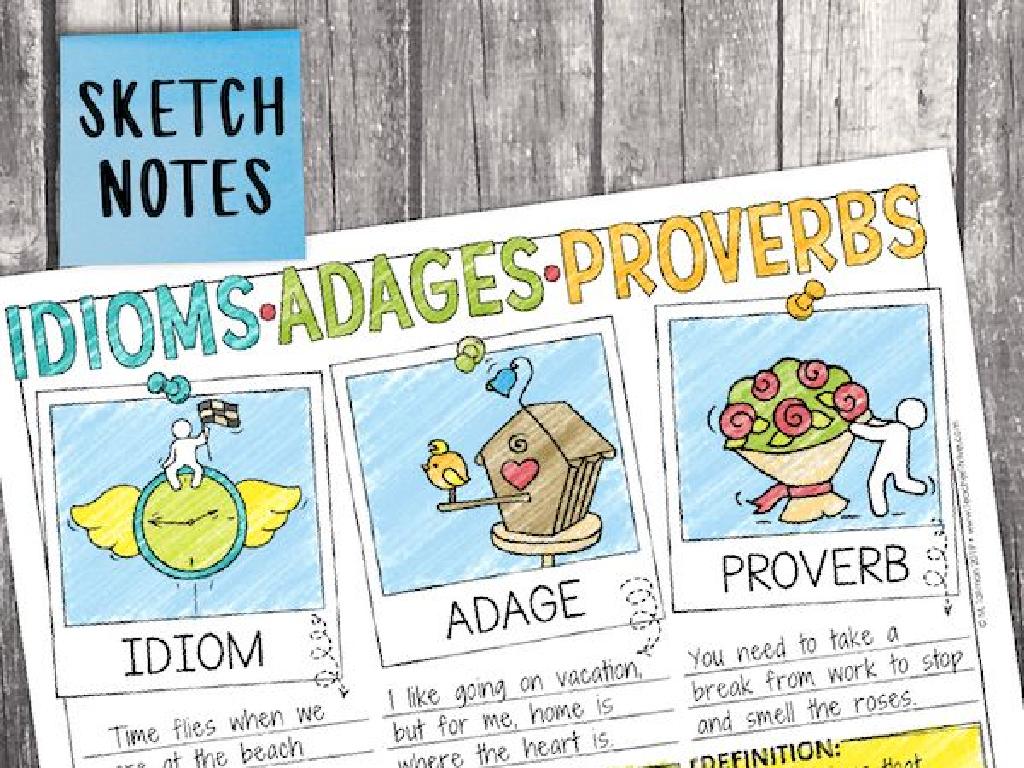Identify Appeals To Ethos, Pathos, And Logos In Advertisements
Subject: Language arts
Grade: Eighth grade
Topic: Persuasive And Opinion Writing
Please LOG IN to download the presentation. Access is available to registered users only.
View More Content
Introduction to Persuasion in Advertising
– Daily life persuasion examples
– Persuasion is all around us, from TV ads to billboards.
– Ethos, Pathos, Logos defined
– Ethos: credibility, Pathos: emotions, Logos: logic
– Ads & persuasive strategies
– Ads often use these to influence our choices.
– Analyzing ad techniques
– We’ll learn to spot these techniques in real ads.
|
This slide introduces students to the concept of persuasion and its prevalence in everyday life, particularly in advertising. Begin by discussing how persuasion is used to influence decisions and behaviors. Introduce the three modes of persuasion: ethos (appealing to ethics or credibility), pathos (appealing to emotions), and logos (appealing to logic). Explain how advertisers use these strategies to persuade consumers to buy products or believe in ideas. Encourage students to think critically about advertisements they encounter and to analyze the persuasive techniques used. This will set the foundation for more in-depth exploration of each persuasive appeal in subsequent lessons.
Ethos: Crafting Credibility in Ads
– Define Ethos in persuasion
– Ethos is an appeal to ethics, convincing with credibility or character.
– Ethos uses in establishing trust
– Ethos is achieved by the speaker’s authority, reputation, or expertise.
– Examples of Ethos in ads
– Celebrity endorsements or expert testimonials in ads are ethos examples.
|
This slide introduces the concept of Ethos as one of the three modes of persuasion in rhetoric. Ethos appeals to the audience’s sense of trust and authority. It’s important for students to understand that advertisers often use ethos to establish credibility and persuade consumers by featuring endorsements from celebrities, experts, or trusted figures. Provide examples such as a famous athlete endorsing a sports drink or a well-known doctor recommending a specific medicine. Discuss how these endorsements create a sense of trust and reliability in the product being advertised. Encourage students to think critically about how ethos is used in ads they encounter in their daily lives.
Pathos: The Emotional Appeal in Ads
– Define Pathos
– Pathos appeals to audience’s emotions.
– How Pathos sways audience
– It influences feelings rather than logic.
– Pathos in ad examples
– Ads may use heartfelt stories or music.
– Analyzing emotional appeal
– We’ll dissect ads to see how emotions are targeted.
|
Pathos is one of the three modes of persuasion in rhetoric (alongside ethos and logos) and refers to the emotional appeal to the audience. An understanding of pathos allows students to recognize how advertisers use emotions to influence consumers’ decisions. Provide examples of advertisements that utilize pathos, such as commercials that use sentimental stories or stirring music to evoke an emotional response. Encourage students to think critically about how these ads are crafted to appeal to their feelings and how this affects their perception of the product. In the next class, students will analyze advertisements to identify the emotional appeals used and discuss the effectiveness of these strategies.
Logos: The Appeal to Logic in Advertising
– Define Logos in persuasion
– Logos is persuading by the use of reasoning.
– Logos uses logic and reasoning
– Facts, statistics, and logical arguments are used to appeal to the audience’s sense of reason.
– Examples of Logos in ads
– ‘9 out of 10 dentists recommend’ uses statistics to persuade.
– Analyzing Logos in class activity
– We’ll look at ads and identify the logical appeals used.
|
This slide introduces the concept of Logos as one of the three modes of persuasion, specifically focusing on its role in advertising. Logos appeals to the audience’s logical side by using facts, statistics, and rational arguments. When advertisers use logos, they’re trying to convince the audience that their product or service is the best choice through logical reasoning. Provide examples of logos in advertisements, such as citing expert opinions, using scientific data, or presenting statistical evidence. For the class activity, encourage students to bring in ads they find at home or from the internet to analyze the logical appeals used. This will help them understand how logos is applied in real-world scenarios and enhance their critical thinking skills.
Identifying Ethos, Pathos, and Logos in Ads
– Tips for spotting ethos, pathos, logos
– Ethos: credibility of speaker; Pathos: emotional appeal; Logos: logical argument
– Analyze ads as a class activity
– We’ll look at real ads and discuss the persuasive techniques used
– Practice with guided ad examples
– Work through examples with the class to identify rhetorical strategies
– Understand persuasive strategies
|
This slide introduces students to the concepts of ethos, pathos, and logos as persuasive strategies in advertisements. Ethos refers to the credibility or trustworthiness of the speaker or brand. Pathos appeals to the audience’s emotions, and logos relies on logic and facts to persuade. The class activity involves analyzing real advertisements to identify these appeals. Provide guided examples to help students practice and reinforce their understanding. Encourage students to think critically about how these strategies are used to influence consumers. The goal is for students to become more discerning viewers of media and to recognize the techniques used to persuade them.
Group Activity: Analyzing Advertisements
– Break into small groups
– Each group gets a unique ad
– Identify ethos, pathos, logos
– Ethos: credibility/trust, Pathos: emotions, Logos: logic/reason
– Discuss the persuasive techniques
– Share examples and effectiveness
|
This group activity is designed to help students apply their understanding of persuasive techniques in a practical setting. By working in small groups, students can engage in collaborative learning and critical thinking. Each group will analyze a different advertisement to identify and discuss how ethos (credibility or ethical appeal), pathos (emotional appeal), and logos (logical appeal) are used to persuade consumers. Teachers should prepare a diverse set of advertisements for the groups, ensuring that they are appropriate for the eighth-grade level. Possible activities include comparing and contrasting the use of persuasive techniques across different ads, creating a presentation on their findings, or even attempting to redesign the ad with a stronger persuasive appeal. The goal is to foster an interactive and engaging learning environment where students can enhance their analytical skills.
Class Discussion: Analyzing Persuasive Appeals
– Groups present their findings
– Discuss effectiveness of appeals
– Why do ethos, pathos, or logos work?
– Explore why some ads persuade better
– Consider emotional, ethical, logical impact
– Engage in Q&A on persuasive techniques
|
This slide sets the stage for a class discussion where students will share their analysis of advertisements and the persuasive appeals they contain. Each group will present the ethos, pathos, and logos appeals they have identified in different ads. The discussion should focus on the effectiveness of these appeals and why they might be convincing to an audience. Encourage students to think critically about the techniques used and how they affect the message of the advertisement. The Q&A session will allow students to ask questions and delve deeper into the art of persuasion. As a teacher, facilitate the discussion, ensuring that each group gets feedback and that students are engaging with the material thoughtfully.
Homework: Analyzing Advertisements
– Find an ad at home
– Write a paragraph on ethos, pathos, logos
– Ethos: credibility, Pathos: emotions, Logos: logic
– Explain the ad’s persuasive power
– Why did the ad convince you to like the product?
– Share your analysis in class
|
This homework assignment is designed to help students apply their understanding of rhetorical strategies to real-world examples. By finding an advertisement at home, students will identify and analyze how ethos (credibility or ethical appeal), pathos (emotional appeal), and logos (logical appeal) are used to persuade consumers. Students should write a paragraph explaining the presence of these appeals in the advertisement and articulate why the ad is persuasive. This exercise will enhance their critical thinking and analytical writing skills. In the next class, students will share their findings, providing an opportunity for peer learning and discussion on the effectiveness of different persuasive strategies in advertising.





